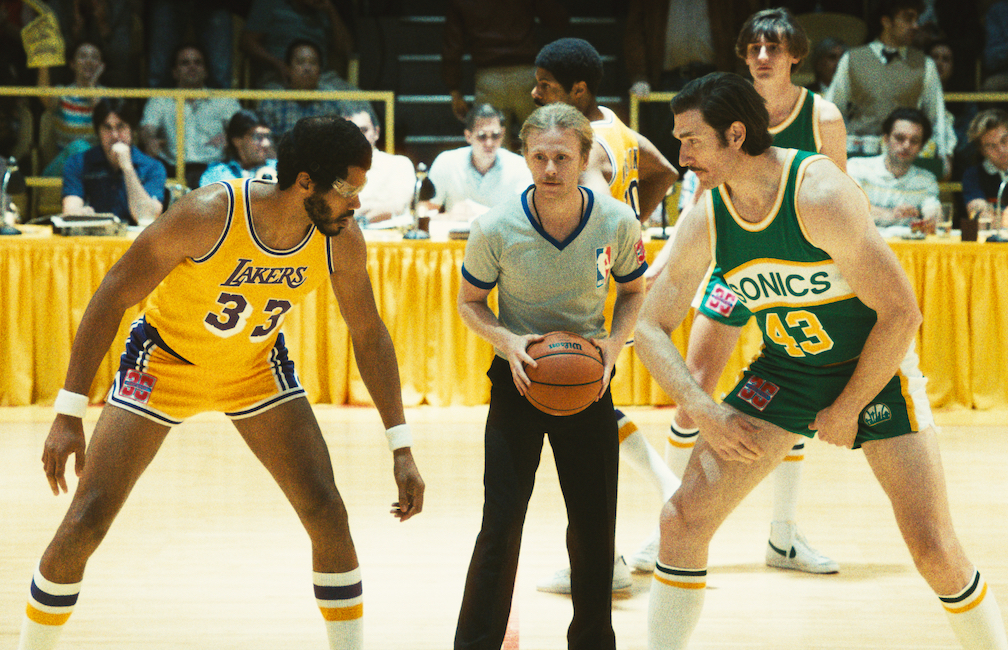
The year is 1980, and tensions are running high in the National Basketball Association, where the Los Angeles Lakers and the Boston Celtics face off in the NBA Finals. This momentous basketball rivalry has been memorialized in the HBO series Winning Time: The Rise of the Lakers Dynasty. Now in season two, it harkens back to just after the 1980 NBA Finals, when NBA head coach Paul Westhead (Jason Segel) and assistant coach Pat Riley (Adrien Brody) led a rookie Earvin “Magic” Johnson (Quincy Isaiah) and the Los Angeles Lakers to the championship, winning six games for the team’s first title in eight years. Continuing to explore the athletes professionally and personally through 1984, the series in season two features the first professional rematch between the era’s greatest star players: the Lakers point guard, the infamous Johnson, and the Celtics small forward and power forward shooter Larry Bird (Sean Patrick Small).
Taking center court is costume designer Emma Potter (TV series Perry Mason, season 3 True Detective, films: Beautiful Boy, Christine, The Devil All The Time, The End Of The Tour, assistant costume designer 127 Hours), who you might say was coached by creator Max Borenstein to fashion the players Johnson and Kareem Abdul-Jabbar (Solomon Hughes) and their charges, Lakers larger-than-life owner Jerry Buss (John C. Reilly), and coach Pat Riley, on and off the court. Potter dribbled back in time to the eighties, referencing real people as models and poring through archival footage and photos for inspiration, including the Laker’s iconic purple and gold uniforms, each one hand-sewn from scratch. The challenge was also fitting their personal styles, such as Riley, who became much more fashion conscious, elevating his look from polyester tracksuits to wearing GQ-worthy designer duds when he was promoted to head coach.
Below The Line spoke with Emma Potter via Zoom video from her home in Los Angeles, where she emigrated from Oxford, England, twenty years ago. Her backdrop was rows of swatches, which Emma described as “waiting to be utilized for her next project” when work resumes once again. Potter discussed the style transformation each character went through in Winning Time since the first season and surprisingly revealed that most of the costumes were created stitch-by-stitch rather than store-bought replicas. She also recalled another sports-themed film she designed at the beginning of her career, which in a way prepared her for Winning Time.
Below The Line: So take me back to the beginning, Emma, and how you got affiliated with Winning Time.
Emma Potter: I initially met executive producer Scott Stephens, who did the pilot for season one of Winning Time. The designer for that pilot was Susan Matheson. I had worked with him a few years earlier on True Detective, so when they were looking for a designer to come on for the season, he recommended me and introduced me to the pilot in the second episode. I was able to put together a book based on my own take on what I would want to bring to the table. Then I sat down with him and Max Borenstein and had our first interview.
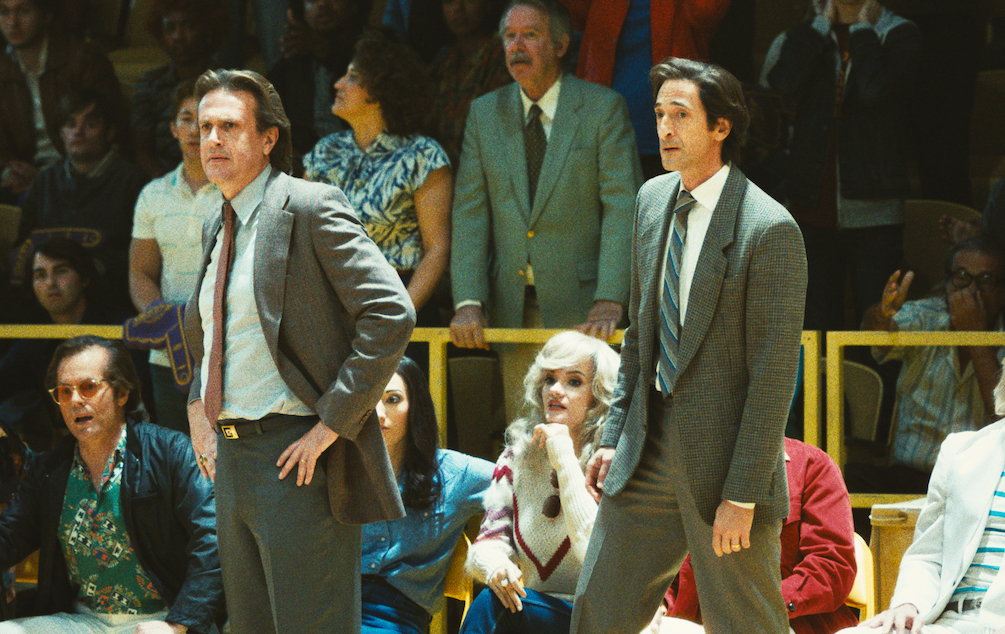
BTL: Would you say that in a way Max Borenstein coached you about what he wanted?
Potter: In the first season, it was a meeting with him and Scott, who had been there for that pilot episode. So they knew the world that I would be diving into, in a sense. Through chatting with them, I was able to gauge the level of detail that we would want to recreate. This idea of having a hyper-realistic take on the world that they’re in while also understanding that there’s drama happening there There are moments that I would have to create without actual references. So that aspect of it felt a little bit like coaching. Between him and (executive producer) Salli Richardson-Whitfield, who came on, there was a lot of using them as guidance.
BTL: Since the series is kind of documentary-style and there’s real people involved, did you want to meet the real people and pick their brain about their clothing style?
Potter: I didn’t reach out. I knew from the beginning that we were not working directly with the NBA or with any of the characters that we were writing about, but we were utilizing material that was from Jeff Pearlman‘s book “Showtime,” as well as going back and looking at people’s biographies or autobiographies, interviews, and accounts. There is a weight that comes with recreating real people that are still here or, sadly, no longer with us, but this idea of wanting to be faithful, honest, and truthful to what they really were like and, in my world, what they really looked like.
I almost found that being able to take a step back and not be speaking with them directly was just purely observational, right? So I’m able to take away what I can from the moments that I can see them in. The wonderful thing about the Showtime era Lakers is that it’s the beginning of all the documentation of them. So there are amazing articles out there where you get to see Kareem at home or Jerry Buss just hanging out in his office. So there were these moments capturing personal aspects of their lives.
BTL: It’s interesting that you didn’t work with the NBA, because the Lakers uniforms are pretty spot on.
Potter: They were faithful recreations, but it’s not like we could use the uniforms that exist now. Everything back then was completely different. I mean, you can look at the shape of the shorts alone and know that those are not the shorts people are playing basketball in anymore. But the fabric that those shorts are made from is different. The lettering and style of the logo are completely different. So it was really more about being able to recreate what it looked like then, which is more of a step back in time as opposed to getting our hands on real NBA uniforms. It was, “Let’s find one sample, and now we have to replicate it because you don’t just need one for Magic Johnson.” He needs multiples, and then there are stunt actors, basketball doubles, and things like that. It’s like another costume in a way, but there’s so much attention to detail in recreating all the little nuances that make it that uniform.
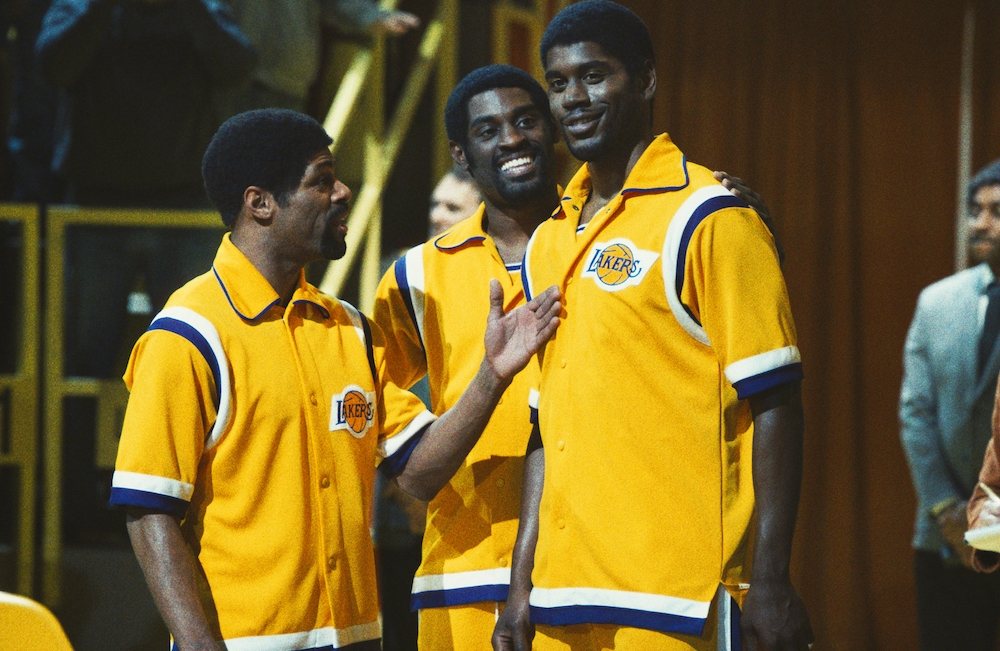
BTL: It’s interesting, and maybe I’m colorblind, but there were times when I felt the purple looked very blue.
Potter: It does at times. It was something we talked about in the first season, and on some of the stock, the purple is kind of rendered somewhat blue, and it’s just interesting to me looking at these different fabrics. Also, in the practice uniforms, the jersey mesh on the top and the shorts are two different materials. So, the same shade actually looks slightly different on both of them. It’s just the way that the camera and the lighting and everything were picking up what we were doing, which was also interesting to catch those kinds of little nuances and those differences.
BTL: You worked so hard on replicating the jerseys and the uniforms. Did you take one home?
Potter: No, I did not. I remember watching and seeing “The Magic is Back” t-shirts, and I was like, “Why didn’t I keep one of those?” But no, I didn’t keep one of the jerseys. They were so precious and hard to make and we needed all of them so much that they just feel like these very special entities and everybody wanted one. They’re all being stored with the show.
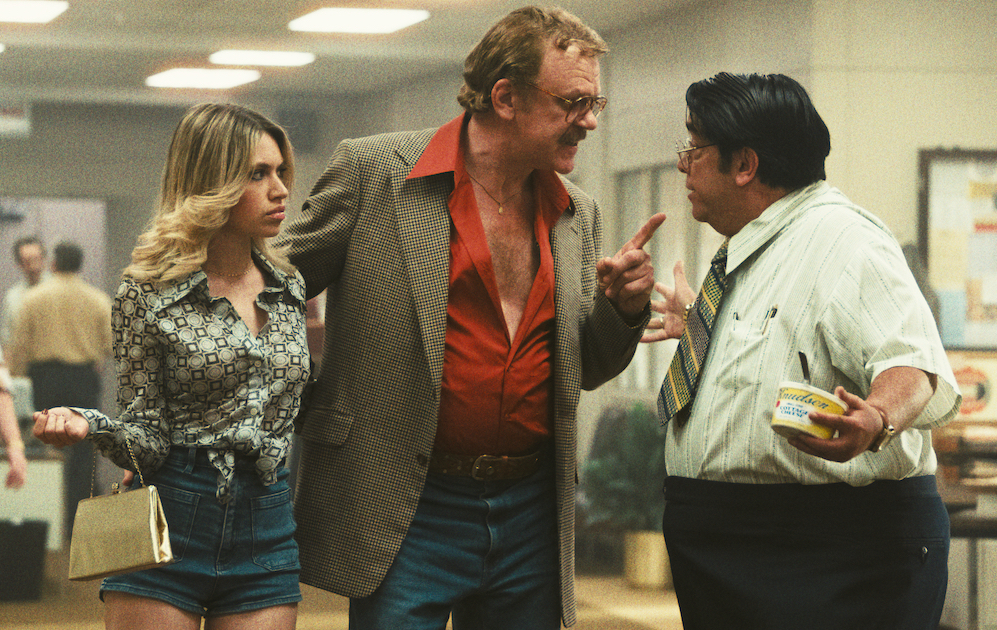
BTL: John C. Reilly as Jerry Buss looks so great in this role. Talk about his off-the-court styles and how those sort of evolved through the second season.
Potter: Working with John was fantastic for me because we kind of established his looks early on in his first season. You look at the photos of Dr. Buss with his fitted jeans and these very long open necklines and fluid silk shirts, and he just seems like a very body-positive figure. We leaned into that and embraced it. We had this conversation at the start of the second season that essentially the whole look overall feels very grounded in the mid-to-late seventies with the bigger collared shirts, the wider lapels, and the flared 517s (jeans).
But when he meets this love interest, we’ve been getting to know that there might be these moments where he starts to cut loose a little bit and embrace the eighties, and those were the moments that, for me, felt very fun because they stepped outside of that personal uniform that his character had. We see a few velour track suits or polyester running suits when he’s getting into the workout fad that’s going on. There are a few new belt buckles or wild-print shirts that show up. Those were moments that we considered to be his personal, at-home kind of style outside of that iconic image of him in the tailored sport coat, silk shirt, and jeans look.
BTL: What about Pat Riley played by Adrien Brody? How did his style change to become the fashionable Pat Riley we know with this slicked back hair and the GQ look?
Potter: He has had the most fantastic visual character arc between seasons one and two. To look back now on season one, when he is in that powder blue checkered seventies suit with the big mustache, the shaggy hair, and the white tie, it’s such a departure. I’d have these big boards in his fitting room that were all the costumes we had done so far and where we were going to be headed. It’s this crisp, kind of effortless Pat Riley crouched down on the court in his Armani suiting. So it was always kind of like, “This looks really good, but it’s too good for right now! We’ve got to scale it back a little bit.”
It was a fun project in terms of figuring out how far we could take it while reserving somewhere else to go. I think one of the big things we talked about was the color palette. A lot of the earlier stuff we see him in is this softer kind of powder blue, or the browns and tan shades. I reserved starker or more contrast to the palette for later on, so towards the mid-eighties, as we get into it, he starts to wear a lot more deep, rich navys, and there’s some black or charcoal gray and some pops of scarlet and deep red that I associate with those very iconic Pat Riley on the court looks. It gave us a very easy visual contrast between suit A and suit B.
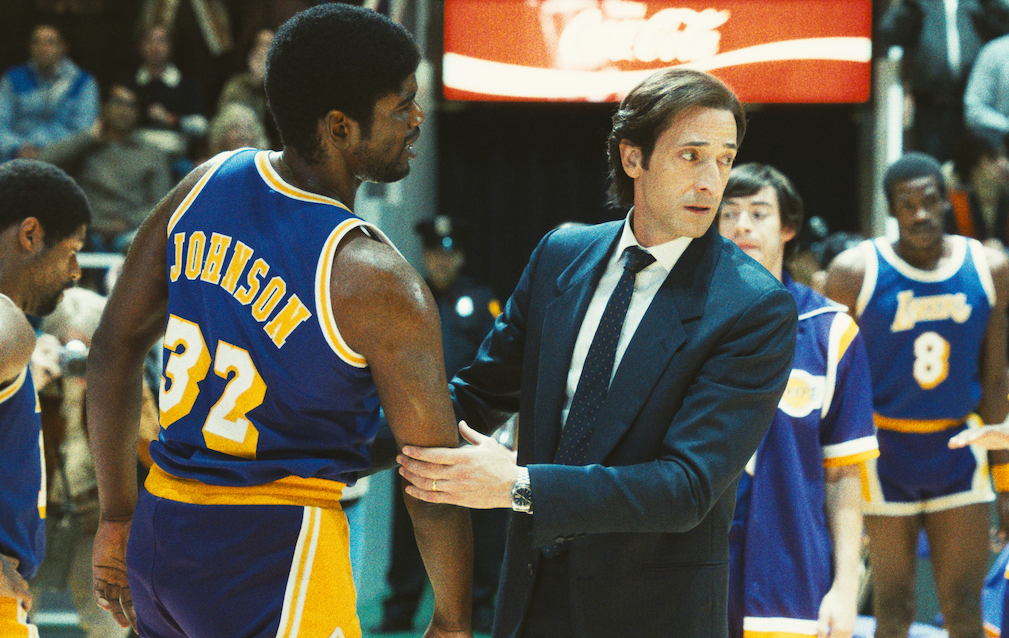
BTL: Off the court Kareem Abdul Jabar is dressed in these colorful tunic tops. How did that reflect his personal style?
Potter: What was so interesting to me was looking at different kinds of photographs of him, and I found a great reference to him in the dashiki shirt; I want to say it was at an event. He was out speaking somewhere, and then I had this other photograph of him that was out in an Adidas polo and track pants. I kind of love the juxtaposition of these two things in his personal wardrobe, and I kind of have those moments.
We reserved the more bold, colorful, printed pieces for truly special moments at home with Cheryl or moments when he would be experiencing, I guess, more joy in his world. Like when we see him go to Palm Springs and Cheryl is pregnant, embracing those looks as we see him throughout the season. In season one, he’s more focused on playing, so he’s in more sporting attire. So we use that to kind of reference what he’s discussing internally or thinking about.
BTL: Where did you source your clothes from Emma?
Potter: A lot of the characters are custom built. For Jerry Buss, we built all of the shirting and the suiting for him. Then the jeans: I was just painstakingly searching to find multiple pairs of 517s that would fit kind of perfectly. Magic Johnson and Kareem were primarily custom-made as well, just because of the sizes that we were looking for. Some of the dashikis we were able to find because they had a shorter sleeve, and if you could find the right length, we were able to use those. For the most part, it was all custom-made. Same from Pat Riley; that’s all custom-made. We worked directly with Armani for some of the later suits for him.
The other characters, like Jerry West or some of the knits, there was some beautiful vintage Missoni, Armani, or Dior that I was able to find working with some vendors throughout the country that we had access to, and everyone else was kind of a mix of that period show. It was just enough of a period that you couldn’t really find too much out there in the world right now to use, so it was about kind of scavenging and hunting and buying up on thrifting, and then kind of filling in from there with pieces that we rented or that we custom made.
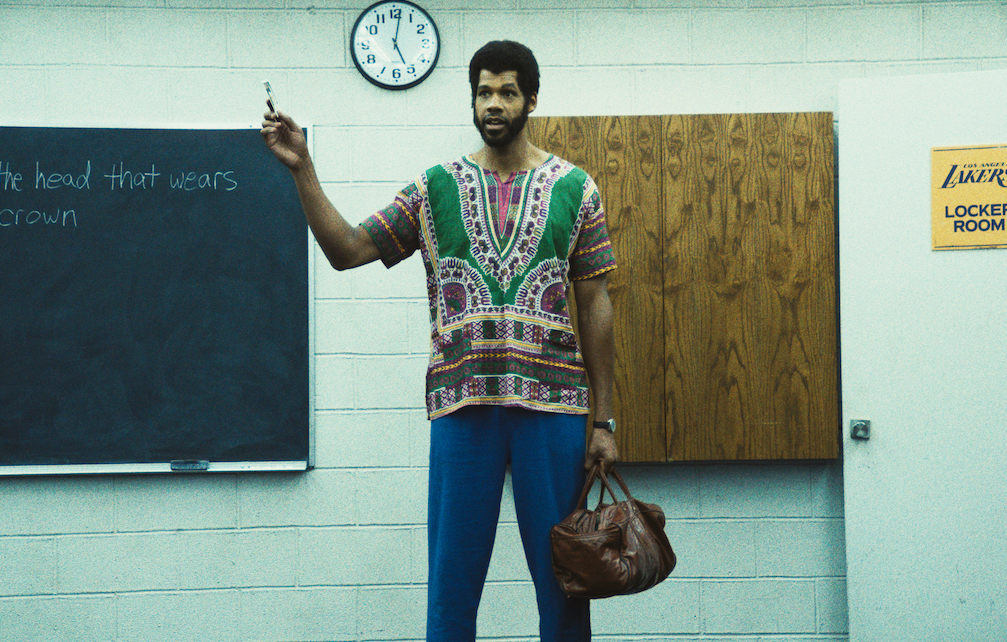
BTL: So when I was doing my homework on you I saw one of your first gigs was as an assistant costume designer on 127 Hours. That is very different from this. What do you remember about those early beginnings?
Potter: I loved that experience, and that was working with Suttirat Anne Larlarb, who is a phenomenal designer. I think for me, it was very inspiring in terms of her work ethic and how methodical she is with approaching all of the minutia of the project at hand. That was kind of instilled in me from the get-go, as was how I would approach work. 127 Hours, in some ways, had some similarities because we had access to the actual clothing that Aron (played by James Franco) had worn down into the canyon. It was my job to help figure out how to replicate that and how to not only replicate it but make it look like it’s one t-shirt when there were actually, I think, close to 60 shirts that he wore that we broke down in various levels for all the different things that happened to him.
I remember listening to her talk, and she said that on shows like that, when you’re doing a really good job and you’re making things look really realistic, the goal would be that no one’s kind of noticing what you’re doing. I’m not quoting it directly, but it was this idea that to get it as real and authentic as possible would almost make it unrecognizable in that someone has made it. I felt like that was reflected in the t-shirt.
People are always kind of amazed that there are 60 of them. I painted all of them so I could remember them! But it’s the same way with some of these costumes on Winning Time—all custom-made, like those uniforms, where the fabrics were woven or knit specifically for us. It’s not just going to the store and finding it. There were a lot of tiny details that went into that big picture.
BTL: So what were some of your slam dunk pieces that helped create that bigger picture, would you say?
Potter: I think one of the things I was most pleased with was watching the transition from 1980 to 1984, like when you’re looking at the kind of crowds in these big scenes. I love being able to be in the space, stand back, and look at this kind of world of people that you’ve created, but you can’t really pinpoint exactly one thing that’s different. It’s just all these little, tiny pieces kind of coming together to make it feel differently. I felt like that was quite successful.
Winning Time: The Rise of the Lakers Dynasty is now available on Max.





